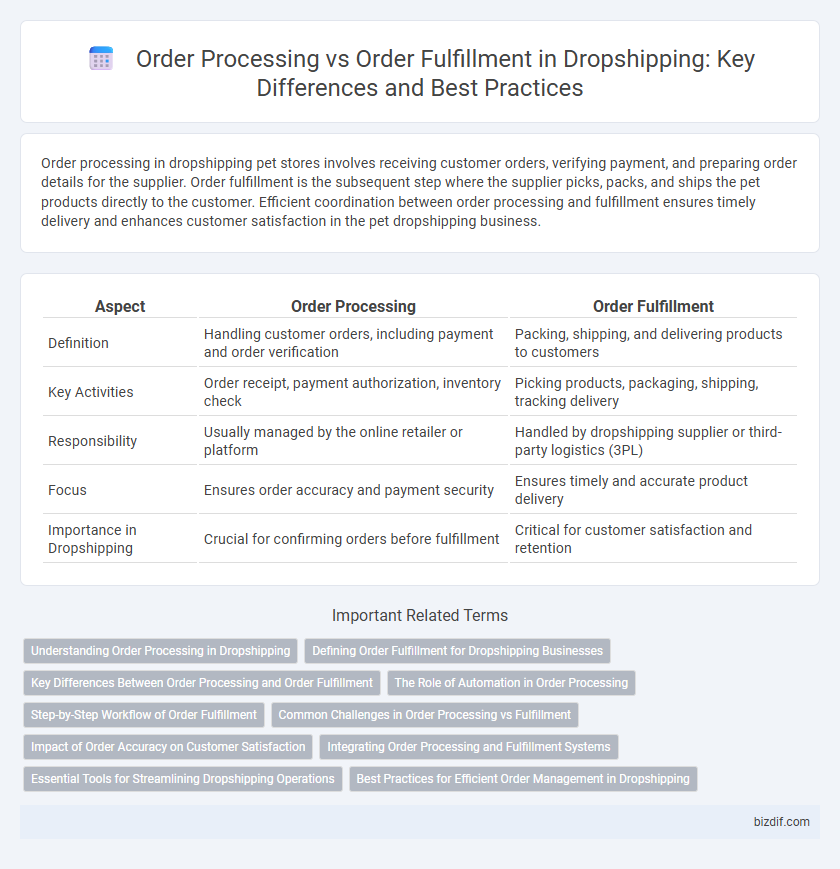Order processing in dropshipping pet stores involves receiving customer orders, verifying payment, and preparing order details for the supplier. Order fulfillment is the subsequent step where the supplier picks, packs, and ships the pet products directly to the customer. Efficient coordination between order processing and fulfillment ensures timely delivery and enhances customer satisfaction in the pet dropshipping business.
Table of Comparison
| Aspect | Order Processing | Order Fulfillment |
|---|---|---|
| Definition | Handling customer orders, including payment and order verification | Packing, shipping, and delivering products to customers |
| Key Activities | Order receipt, payment authorization, inventory check | Picking products, packaging, shipping, tracking delivery |
| Responsibility | Usually managed by the online retailer or platform | Handled by dropshipping supplier or third-party logistics (3PL) |
| Focus | Ensures order accuracy and payment security | Ensures timely and accurate product delivery |
| Importance in Dropshipping | Crucial for confirming orders before fulfillment | Critical for customer satisfaction and retention |
Understanding Order Processing in Dropshipping
Order processing in dropshipping involves receiving and managing customer orders, verifying product availability, and forwarding order details to suppliers for shipment. This step ensures accurate communication between the retailer and supplier, reducing errors and delays in delivery. Efficient order processing is critical for maintaining customer satisfaction and streamlining the supply chain in dropshipping operations.
Defining Order Fulfillment for Dropshipping Businesses
Order fulfillment in dropshipping involves receiving customer orders, sourcing products directly from suppliers, and ensuring timely shipment without holding inventory. Key components include coordinating supplier inventory, managing shipment tracking, and handling returns efficiently to maintain customer satisfaction. Streamlined order fulfillment minimizes delays and reduces errors, which is crucial for scaling a dropshipping business.
Key Differences Between Order Processing and Order Fulfillment
Order processing involves receiving and managing customer orders, including payment verification and inventory updates, while order fulfillment focuses on picking, packing, and shipping the products to customers. Key differences include order processing being primarily administrative and digital, whereas fulfillment is operational and logistics-based. Efficient integration of both stages ensures seamless dropshipping operations, reducing errors and enhancing customer satisfaction.
The Role of Automation in Order Processing
Automation streamlines order processing by instantly verifying inventory, generating invoices, and updating order status, significantly reducing manual errors and processing time. In dropshipping, automated systems integrate with suppliers' platforms to ensure seamless coordination from order receipt to shipment, enhancing customer satisfaction. Efficient automation tools enable real-time tracking and prompt communication, crucial for maintaining competitive fulfillment standards.
Step-by-Step Workflow of Order Fulfillment
Order fulfillment in dropshipping involves a step-by-step workflow starting with receiving the order from the customer, then transmitting order details to the supplier or manufacturer for packaging and shipment. After the supplier ships the product, tracking information is sent to the customer, ensuring transparency and timely updates. This contrasts with order processing, which mainly covers order verification, payment authorization, and inventory checks before fulfillment begins.
Common Challenges in Order Processing vs Fulfillment
Order processing and order fulfillment in dropshipping face common challenges such as inventory discrepancies, delayed communication between suppliers and retailers, and accuracy in order details. Ensuring real-time stock updates and minimizing shipment errors are critical to maintaining customer satisfaction. Efficient integration of order management systems with supplier platforms helps mitigate these issues and streamline operations.
Impact of Order Accuracy on Customer Satisfaction
Order accuracy in dropshipping directly influences customer satisfaction by ensuring timely and correct product delivery, reducing return rates and enhancing brand reputation. Precise order processing minimizes errors such as wrong items or incorrect quantities, leading to fewer customer complaints and higher repeat purchase rates. Efficient order fulfillment systems that prioritize accuracy help maintain positive reviews and build trust, crucial for long-term business growth in competitive dropshipping markets.
Integrating Order Processing and Fulfillment Systems
Integrating order processing and fulfillment systems streamlines dropshipping operations by ensuring real-time synchronization of inventory, payment verification, and shipment tracking. Automated workflows reduce errors and accelerate delivery times, enhancing customer satisfaction and operational efficiency. Leveraging APIs and cloud-based platforms enables seamless communication between order management software and logistics partners, optimizing the entire supply chain process.
Essential Tools for Streamlining Dropshipping Operations
Order processing and order fulfillment are critical components of dropshipping, with tools like Shopify and Oberlo automating the transfer of customer orders to suppliers for efficient handling. Inventory management software such as TradeGecko or Zoho Inventory helps track stock levels in real time, reducing errors and delays. Integrating shipping solutions like ShipStation further streamlines the shipment process, ensuring timely delivery and improved customer satisfaction.
Best Practices for Efficient Order Management in Dropshipping
Efficient order management in dropshipping hinges on distinguishing order processing, which involves receiving and verifying customer orders, from order fulfillment, the actual packaging and shipping handled by suppliers. Best practices include automating order processing through integrated software to minimize errors and delays while maintaining real-time communication with suppliers for accurate fulfillment tracking. Leveraging tools like Shopify or Oberlo streamlines the coordination between processing and fulfillment, enhancing customer satisfaction and operational efficiency.
Order processing vs order fulfillment Infographic

 bizdif.com
bizdif.com